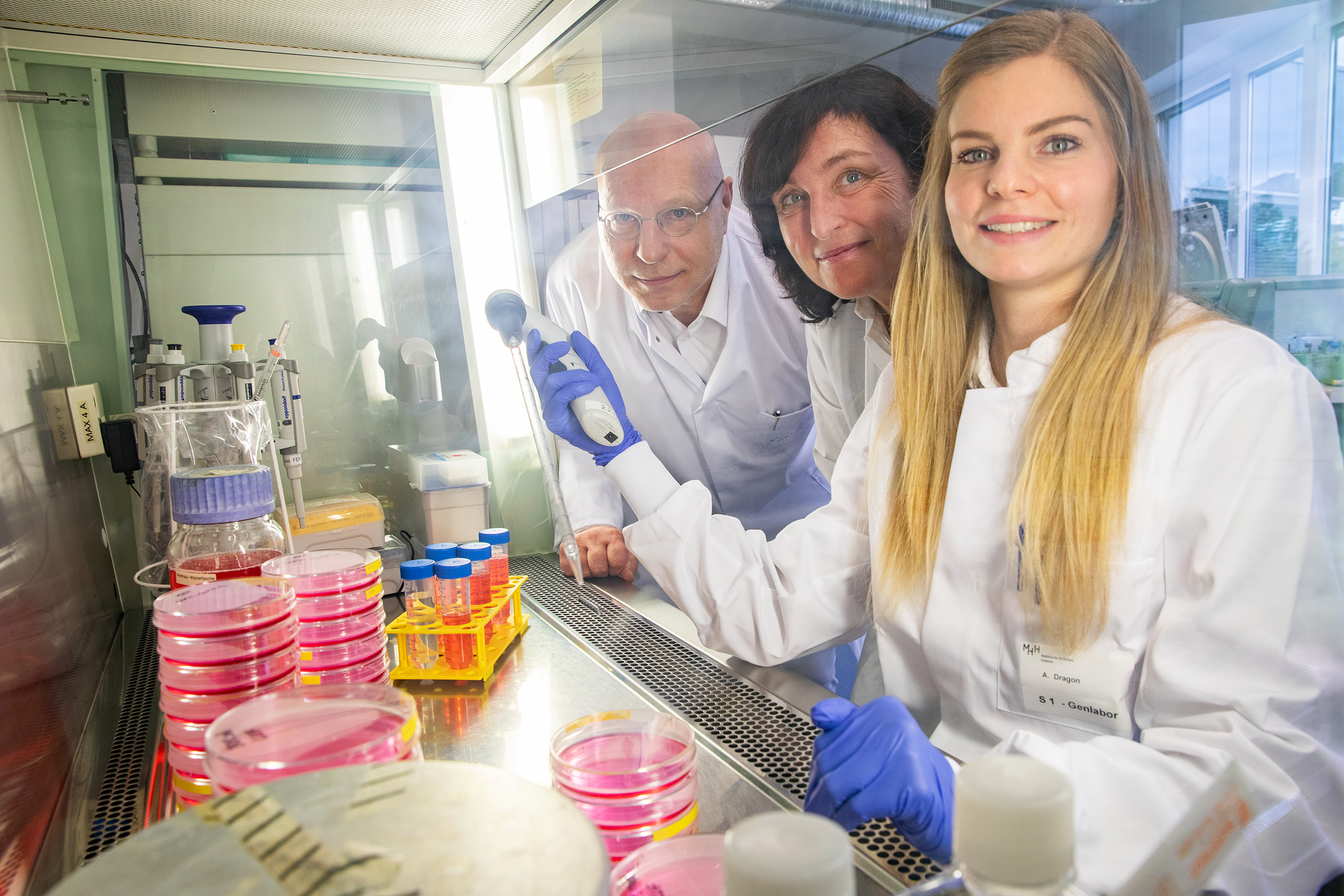A donated organ always remains foreign to the body and is fought against by the immune system. In order to prevent rejection, the entire immune defence must be suppressed for a lifetime. An MHH research team is now using genetically modified killer cells against precisely those immune cells that want to destroy the transplant.

Relying on modified killer cells to combat organ rejection after transplantation: Professor Dr Rainer Blasczyk, Professor Dr Britta Eiz-Vesper (centre) and Dr Anna Dragon. Copyright: Karin Kaiser / MHH
If an organ is incurably diseased and fails, the only remaining treatment option is a transplant. However, the recipient's immune system recognises the donor organ as foreign based on tissue characteristics and attacks it. In order to prevent or at least delay rejection, the immune system must be suppressed – for life. These immunosuppressive therapies often work by restricting the activity of defence cells and thus preventing the formation of antibodies and the activation of immune cells. Although this mechanism protects the donor organ, it also facilitates infections caused by viruses, fungi and bacteria.
A research team led by Dr Anna Christina Dragon from the Institute of Transfusion Medicine and Transplant Engineering at Hannover Medical School (MHH) is now developing a new type of cell therapy to preserve organ function without simultaneously eliminating the entire immune response: instead of completely suppressing the immune response, as has been the case up to now, the biomedical scientist wants to specifically eliminate only those antibody-producing immune cells that cause organ rejection. The project is being funded by the Else Kröner-Fresenius Foundation with around 280,000 euros over 36 months.
B cells form antibodies against the transplant
"The humoral immune response by certain B cells, which recognise the transplant as foreign, is largely responsible for the rejection," explains the young scientist. The structures on the surface of the body cells, the so-called human leukocyte antigens (HLA), are decisive for this. Based on these tissue characteristics, our immune system can differentiate between our own and foreign tissue. The more similar the HLA characteristics of the organ donor and recipient are, the lower the risk of rejection. However, identical HLA characteristics are found almost exclusively in some siblings. If the foreign HLA characteristics of the transplant are recognised by B cells with anti-donor HLA specificity, they form antibodies. These bind to the cells of the donated organ and initiate their destruction.
CORA T cells should ensure the survival of the organ
"In order to eliminate these antibody-producing B cells before they can cause any damage, we use other immune cells of the patient – the so-called T cells – which we convert into killer cells through genetic modification so that they precisely eliminate the responsible B cells that would otherwise produce antibodies against the transplant," explains Dr Dragon. For this purpose, she equips the T cells with an artificial receptor. This consists of an outer HLA molecule, which attaches itself precisely to the anti-HLA structure of the B cells, and an inner signalling unit. This receptor then guides the T killer cell to the B cells like a navigation device. The scientist calls these helpers against organ rejection CORA T cells (T cells overcoming rejection by antibodies). "The approach is very innovative and has the potential to effectively improve the long-term survival of the donated organ after transplantation," emphasises Professor Dr Britta Eiz-Vesper, immunologist at the Institute and expert in immunotherapies.
Therapeutic potential not only for transplant medicine
In preliminary work, Dr Dragon was already able to prove in cell culture that the principle works. She equipped T cells with a receptor from the most common HLA characteristic (HLA-A2) and was able to observe that these CORA T cells actually tracked down and destroyed precisely those B cells that had the precise antibodies against HLA. This then led to a significant reduction in the release of the harmful antibodies. In contrast, B cells with a different specificity that were also present in the cell culture were completely spared. Two further HLA receptors are currently being constructed and tested. "There are several genes in the HLA system, which also exist in many variants," says the young researcher. "I'm focussing on the most important and most widespread variants for transplantation." The aim is to soon build up a CORA T-cell bank with the most common HLA variants and then make these available to patients for customised transplants.
"This approach would also help to improve the existing problem of living kidney donations in Germany," emphasises Institute Director Professor Dr Rainer Blasczyk. In Germany, only first and second-degree relatives, spouses or partners are allowed to donate their kidneys. "Donors are therefore not selected based on whether their organ is a good match for the recipient, which leads to enormous problems when it comes to second transplants at the latest," regrets the transplantation physician. "With this completely new approach of CORA T cells, the previously unsolved problem of HLA incompatibilities can be overcome and the long-term survival of transplants is within reach."
Honoured with Leonardo da Vinci Award
The experts also recognise the potential. At the meeting of the European Society for Organ Transplantation (ESOT) in Athens in September, the young scientist was honoured for her work with the highest prize, the Leonardo da Vinci Award, worth 10,000 euros. However, the potential applications go beyond transplantation medicine. "Wherever antibody-mediated immune responses cause problems, the use of these killer T cells could help," explains Professor Eiz-Vesper. In addition to rejection reactions, this also applies to allergies and autoimmune diseases. "If we exchange the recognition structures of the receptors, we can theoretically send the killer cells against all kinds of antibody-producing B cells," says young scientist Dr Dragon.
Text: Kirsten Pötzke